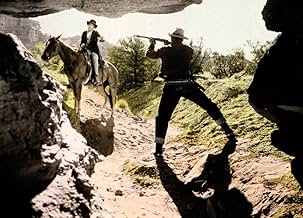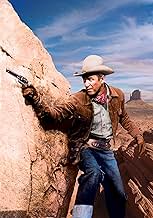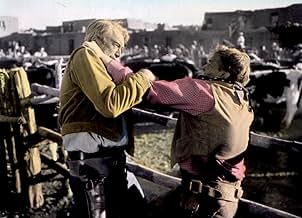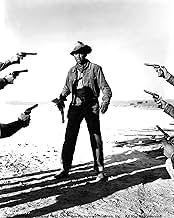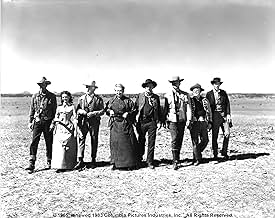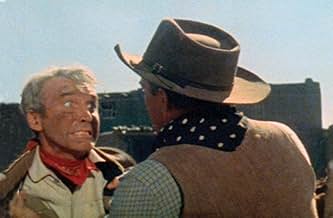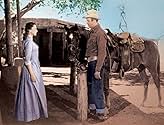IMDb-BEWERTUNG
7,3/10
12.795
IHRE BEWERTUNG
Der Neuankömmling Will Lockhart trotzt dem örtlichen Viehbaron und seinem sadistischen Sohn, indem er für einen seiner ältesten Rivalen arbeitet.Der Neuankömmling Will Lockhart trotzt dem örtlichen Viehbaron und seinem sadistischen Sohn, indem er für einen seiner ältesten Rivalen arbeitet.Der Neuankömmling Will Lockhart trotzt dem örtlichen Viehbaron und seinem sadistischen Sohn, indem er für einen seiner ältesten Rivalen arbeitet.
- Regie
- Drehbuch
- Hauptbesetzung
Beulah Archuletta
- Woman at Indian Wedding
- (Nicht genannt)
Jack Carry
- Mule Driver
- (Nicht genannt)
Bill Catching
- Mule Driver
- (Nicht genannt)
Frank Cordell
- Mule Driver
- (Nicht genannt)
Empfohlene Bewertungen
Another solid western by a man who gave some of the best works of the whole genre (the naked spur, cimarron,etc).This is the story of a double search:Stewart is looking for the man who's responsible for his brother 's death.Crisp is afraid of a man who might possibly kill his son:he has a recurrent dream which frightens him .Little by little the two stories converge and make one in one of the most brilliant western screenplays of the fifties.The dreamlike touch gives a movie another dimension,which only great directors can conjure :Walsh,Ford ,Daves,or of course Mann.
The characters are more complex than we thought at first sight,and the cliché of the old wealthy man with a son -black-sheep-of-the-family and an almost- adoptive- son-good-boy is avoided.Alex Nicol and Arthur Kennedy give strong nervous tortured portrayals which almost outshine star Stewart.Crisp is equally effective in the part of a man who tries not to face the truth -which may be the meaning of his premonitory dream-,and will finally see it when he is blind.The lead female part is the weakest link of the movie ,but Aline MacMahon's colorful Kate more than makes up for Cathy O'Donnell's blandness.
I had seen this movie for the first time when I was 13.I saw it again yesterday.It has not aged a bit.
The characters are more complex than we thought at first sight,and the cliché of the old wealthy man with a son -black-sheep-of-the-family and an almost- adoptive- son-good-boy is avoided.Alex Nicol and Arthur Kennedy give strong nervous tortured portrayals which almost outshine star Stewart.Crisp is equally effective in the part of a man who tries not to face the truth -which may be the meaning of his premonitory dream-,and will finally see it when he is blind.The lead female part is the weakest link of the movie ,but Aline MacMahon's colorful Kate more than makes up for Cathy O'Donnell's blandness.
I had seen this movie for the first time when I was 13.I saw it again yesterday.It has not aged a bit.
The Man from Laramie (1955)
You have a right to expect a movie starring James Stewart, directed by Anthony Mann, and photographed by Charles Lang to be spectacular. And it is. This is one of the first full wide screen Technicolor movies, and it's one drawback might be that it is trying to apply a new format to an old and slightly tired genre. The fact it rises above its familiarity is to Stewart's credit and Mann's. Lang (who photographed an extraordinary number of great black and white films) trades stately perfect color and design for pure drama and intensity, which are very different things, but it gives a full backdrop to the high drama here.
This is a beautiful movie, for sure, in its restrained way. (The fact that it's restrained when the whole world is gaping for surging new big color movies is a small miracle in itself.) Mann did a number of westerns, for which he's most known, and a few other genre pics, but first made his name as a film minor film noir director. He seems to carry over enough of the edginess and cruelty of those noirs to make his Westerns exciting rather than epic, which is a good thing. He and Stewart worked together on five westerns, and they have taken on a life of their own, and a feeling of their own that's impressive once you click into it. One of the best noir elements to the story (which was not written by Mann) is the feeling of the lone man against the world, a great theme.
The key woman lead is a cliché, the widow hanging on against the odds in town. In this case she is a charming but slightly miscast Cathy O'Donnell, a favorite of mine who takes demur and innocent to the heights. You see from the outset that this widow and Stewart's good, hard working character are destined for some kind of meeting of destinies. And there are inevitable clichés, too, that you might get used to--the stoic Indians, the older woman as tough as nails (and a gem of a role), a patriarch with a thoughtful wise look that shows counteracting wisdom, and fistfights in the dust. It's all great stuff, in the Western mold. (One fight is right in the middle of a mooing herd of cattle, and it's pretty fun.)
You do wonder sometime at the possibility of a super nice guy sticking it out against all these obstacles, and I mean obstacles. The domineering (and sometimes evil) family led by Donald Crisp, with the always impressive Arthur Kennedy as the chief hand, seems like more than a man could handle. But the conflict is real, and the movie makes it pertinent beyond being "just" a western. And beautifully done. Even if you don't like westerns, this will grab you anyway.
You have a right to expect a movie starring James Stewart, directed by Anthony Mann, and photographed by Charles Lang to be spectacular. And it is. This is one of the first full wide screen Technicolor movies, and it's one drawback might be that it is trying to apply a new format to an old and slightly tired genre. The fact it rises above its familiarity is to Stewart's credit and Mann's. Lang (who photographed an extraordinary number of great black and white films) trades stately perfect color and design for pure drama and intensity, which are very different things, but it gives a full backdrop to the high drama here.
This is a beautiful movie, for sure, in its restrained way. (The fact that it's restrained when the whole world is gaping for surging new big color movies is a small miracle in itself.) Mann did a number of westerns, for which he's most known, and a few other genre pics, but first made his name as a film minor film noir director. He seems to carry over enough of the edginess and cruelty of those noirs to make his Westerns exciting rather than epic, which is a good thing. He and Stewart worked together on five westerns, and they have taken on a life of their own, and a feeling of their own that's impressive once you click into it. One of the best noir elements to the story (which was not written by Mann) is the feeling of the lone man against the world, a great theme.
The key woman lead is a cliché, the widow hanging on against the odds in town. In this case she is a charming but slightly miscast Cathy O'Donnell, a favorite of mine who takes demur and innocent to the heights. You see from the outset that this widow and Stewart's good, hard working character are destined for some kind of meeting of destinies. And there are inevitable clichés, too, that you might get used to--the stoic Indians, the older woman as tough as nails (and a gem of a role), a patriarch with a thoughtful wise look that shows counteracting wisdom, and fistfights in the dust. It's all great stuff, in the Western mold. (One fight is right in the middle of a mooing herd of cattle, and it's pretty fun.)
You do wonder sometime at the possibility of a super nice guy sticking it out against all these obstacles, and I mean obstacles. The domineering (and sometimes evil) family led by Donald Crisp, with the always impressive Arthur Kennedy as the chief hand, seems like more than a man could handle. But the conflict is real, and the movie makes it pertinent beyond being "just" a western. And beautifully done. Even if you don't like westerns, this will grab you anyway.
Director Anthony Mann and actor James Stewart combined to make several westerns and they were all very good. Make that "excellent." This is one of them and it gets high marks for an involving story.
It also features what I call "realistic dialog," along with interesting characters and a film noir feel to it. That's no surprise since Mann directed a few film noirs. Along that noir theme, be warned this is not an upbeat story, a feel-good Jimmy Stewart film that most people remember him by. In here, he's a vengeful guy here (but, yeah, still a good man at heart). Donald Crisp also demonstrates an overt double-edged sword, so to speak, being a very gruff but fair land owner.
Some of the best lines in the movie are delivered by Ailine MacMahon, an older woman friend who helps Stewart. Cathy O'Donnell plays the female romantic lead but is a bit on the bland side, frankly.
Good story.....solid western.....deserves to be better known. Buy the DVD. It''s cheap. You won't be sorry.
It also features what I call "realistic dialog," along with interesting characters and a film noir feel to it. That's no surprise since Mann directed a few film noirs. Along that noir theme, be warned this is not an upbeat story, a feel-good Jimmy Stewart film that most people remember him by. In here, he's a vengeful guy here (but, yeah, still a good man at heart). Donald Crisp also demonstrates an overt double-edged sword, so to speak, being a very gruff but fair land owner.
Some of the best lines in the movie are delivered by Ailine MacMahon, an older woman friend who helps Stewart. Cathy O'Donnell plays the female romantic lead but is a bit on the bland side, frankly.
Good story.....solid western.....deserves to be better known. Buy the DVD. It''s cheap. You won't be sorry.
On his way to a mixed-race village, a lone cowboy seems mysteriously fascinated by charred clothing he finds on the trail. Once in town he finds little more than conflict between himself and a rancher's family, including the crafty foreman and a belligerent son. So what's going on with the lone cowboy and his apparent mission.
If you've got a yearn for wide-open spaces, this is the western to catch. From desert flats to rocky cliffs, the screen's filled with Mother Nature at her most expansive. Happily most of the action takes place among these great sights. To me, the vistas are the movie's best feature among stiff competition. For example, it's also an exceptionally well-acted oater, though O'Donnell seems a little too delicately saccharine for a frontier gal. Nonetheless, Kennedy is in fine form as the crafty Vic, who's an excellent foil for Stewart as the lone cowboy Lockhart. And, of course, Stewart is Stewart, low-key, but determined.
All in all, for a western, the storyline's unusually complex featuring a number of subplots. But then, 1955 was a time when Hollywood went for big screen epics in its battle with front room TV's. So producers had to fill out the narratives to increase runtimes befitting more epic proportions and name casts. Here the subplots-- old lady MacMahon, sinister Elam, wacko Nicol-- are mostly agreeable, but don't tighten the impact, which is clearly Stewart's odd relationship with Kennedy. Speaking of impact, there're several memorable scenes that lift results. Maybe the most memorable is Stewart getting dragged through the smoking campfire that's excellently staged and photographed. No doubt that's due to director Mann who knew how to make viewers feel and not just see. Then too, the difficult father-son relation between father Crisp and substitute son Kennedy is both poignant and sensitively performed. No wonder Kennedy was cast in what amounts to a difficult good-guy bad-guy role.
All in all, it's an ace western, a little loose in construction, but with moments of memorable excellence.
If you've got a yearn for wide-open spaces, this is the western to catch. From desert flats to rocky cliffs, the screen's filled with Mother Nature at her most expansive. Happily most of the action takes place among these great sights. To me, the vistas are the movie's best feature among stiff competition. For example, it's also an exceptionally well-acted oater, though O'Donnell seems a little too delicately saccharine for a frontier gal. Nonetheless, Kennedy is in fine form as the crafty Vic, who's an excellent foil for Stewart as the lone cowboy Lockhart. And, of course, Stewart is Stewart, low-key, but determined.
All in all, for a western, the storyline's unusually complex featuring a number of subplots. But then, 1955 was a time when Hollywood went for big screen epics in its battle with front room TV's. So producers had to fill out the narratives to increase runtimes befitting more epic proportions and name casts. Here the subplots-- old lady MacMahon, sinister Elam, wacko Nicol-- are mostly agreeable, but don't tighten the impact, which is clearly Stewart's odd relationship with Kennedy. Speaking of impact, there're several memorable scenes that lift results. Maybe the most memorable is Stewart getting dragged through the smoking campfire that's excellently staged and photographed. No doubt that's due to director Mann who knew how to make viewers feel and not just see. Then too, the difficult father-son relation between father Crisp and substitute son Kennedy is both poignant and sensitively performed. No wonder Kennedy was cast in what amounts to a difficult good-guy bad-guy role.
All in all, it's an ace western, a little loose in construction, but with moments of memorable excellence.
...with this Technicolor tale examining vengeance, moral culpability, and familial loyalty. Stewart plays Will Lockhart, whose brother was killed in a cavalry ambush. The ambush was carried out by the Apaches. The question Lockhart wants answered is who provided the Apaches with the rifles used in the attack. His journey takes him to a sprawling ranch in New Mexico, lorded over by Alec Waggoman (Donald Crisp), a man who may have lived by the ethos of rugged individualism, but now, in his twilight, develops a belated sense of right and wrong.
The film also stars Arthur Kennedy as the faithful ranch employee who simmers with resentment over not being appreciated; Alex Nicol as Waggoman's hotheaded son, a character with a violent streak; and Cathy O'Donnell as Alec's niece and Lockhart's love interest.
The film also stars Arthur Kennedy as the faithful ranch employee who simmers with resentment over not being appreciated; Alex Nicol as Waggoman's hotheaded son, a character with a violent streak; and Cathy O'Donnell as Alec's niece and Lockhart's love interest.
Wusstest du schon
- WissenswertesJames Stewart stated that of all the westerns he made this one was his personal favorite.
- PatzerTwo of Dave's men are holding Lockhart as Dave prepares to shoot Lockhart's hand. One of the two men is in the direct line of fire, and since Dave is shooting Lockhart's hand at point blank range, the bullet would have gone through his hand and struck Dave's henchman.
- Zitate
Will Lockhart: What are you stickin' your neck out for, Charley?
Charley O'Leary: I'm a lonely man, Mr. Lockhart. So are you. I don't suppose we spoke ten words comin' down here, but I feel that I know ya, and I like what I know.
- VerbindungenFeatured in Nicht so schnell, mein Junge (1966)
Top-Auswahl
Melde dich zum Bewerten an und greife auf die Watchlist für personalisierte Empfehlungen zu.
- How long is The Man from Laramie?Powered by Alexa
Details
Box Office
- Weltweiter Bruttoertrag
- 6.317 $
- Laufzeit
- 1 Std. 43 Min.(103 min)
Zu dieser Seite beitragen
Bearbeitung vorschlagen oder fehlenden Inhalt hinzufügen



